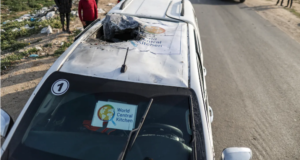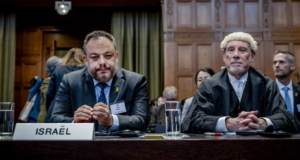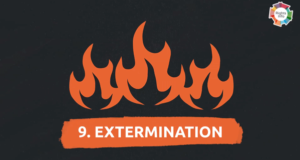By Eva Bartlett
ingaza.wordpress.com
Every time I manage to make it back to Gaza to write for a period, a new calamity.
“They’re shelling Awda hospital,” in Jabaliya, the news reports. Our internationals there at the moment report it was two shells at a police post next to the hospital, one hospital worker getting shrapnel to the head, but surviving.
The numbers slaughtered and injured are so high now – 521 and 3,000 as of this morning, Gaza time – that sitting next to a dead or dying person is becoming normal. The stain of blood on the ambulance stretcher pools next to my coat, the medic warning me my coat may be dirtied. What does it matter? The stain doesn’t revolt me as it would have, did, one week ago. Death fills the air, the streets in Gaza, and I cannot stress that this is no exaggeration.
Back in Gaza city briefly, after a day and night again with the medics, I’ll try to summarize, though there is too much to tell, too much incoming news, and it’s too hard to reach people, even those just a kilometer away. Before dropping me off, the medics had gone to different gas stations, searching for gas for the ambulances. Two stations, no luck. Some at a final source fills their tanks. The absence of gas is critical. So is the absence of bread, which goes on, the lines longer than ever yet.
A text tells me (at this point I have to rely on news from phone and text messages, when reception is available) that the UN says 13,000 have been displaced since these attacks, that 20% of the dead are women and children, 70% are without drinking water. There are many more facts to sober one drunk on apathy, but I can’t source or share them now.
The Israeli army occupied areas in the north, shelled houses, demolishing them, many injuries, dead, many off-limits to the ambulances.
Beit Hanoun is occupied by the Israeli army, which is now controlling the entry points to the northern region, cutting it off. One small, sub-par hospital without an ICU is staggering under the influx of injured from house demolitions, shellings, shootings… Two ambulances serve this region, I don’t have any information on their condition, the amount of petrol they have, or what areas of the Beit Hanoun region are accessible or not.
Entering via an ambulance to take an emergency case to Gaza’s Shifa hospital, I see the Beit Hanoun hospital crammed, with a frenzied air, families desperate to get their injured care…those who have been able to get to the hospital. Mohammed Sultan, 19, stands dazed with a gunshot graze to the back of his head. From Salateen, northwestern Gaza, he had to walk 1 km before a car could reach him and take him here.
The man we transfer to Shifa has been shot in the face. He is about 35, is a civilian, was in or near his house. His face has exploded, and we move as fast as possible over torn up roads, ambulance jarring as we move and as the medics try to administer delicate care. It’s on everyone’s mind that the army is present here, that our safety is not.
Beit Lahia and beyond, in the northwest, are mostly off-limits to ambulances, leaving the wounded and dead where they are. The calls from there for help, for evacuation, have been non-stop and now go ignored.
In Zaytoun, reports have one extended family being separated men from women, locked inside two houses, and the houses shelled a day later (this morning, around 11 am). Bodies are still being pulled and carted to Shifa hospital. Many estimate that as many as 20 were killed, 10s more injured. I will go to Shifa after this to try to confirm numbers, though again the disclaimer that confirmation in these conditions takes time (and working phone lines). Zaytoun area is occupied in parts, making ambulance access again nearly-impossible, if not fully, I don’t know at this point.
I’m told that areas further south have been invaded, shelled, occupied. Like Zahara, and Juhadik in central Gaza. Press TV reporter Yusuf al Helo told me this morning that the reason he hadn’t answered my phone calls last night (he is one of the better sources for up-to-date news) was because his uncle, in the extended Zaytoun area, just off the main Salah el Din street, was killed when Israeli forces shelled their house. “My cousins were in the house too,” he told me, as were many more injured. Over 15 hours after the assault, Yusuf updates me: “until now they still haven’t been able to take the injured and dead out of my uncle’s house.”
Last night, in a Jabaliya hospital, I talk with one nurse who tells us that his brother Adham, an 8 year old, was shot in the neck and in the chest at 4:30 pm that day (January 4th) when on his rooftop in the same northwestern area that ambulances now cannot reach.
Mohammed tells me his village, Khosar, east of Khan Younis was shelled in an agricultural area, one of the many open areas continuing to be pummelled. One of the many areas period: open, residential, market…
Painfully, I learn that after a hasty funeral, Arafa’s mourning tent was shelled yesterday, mourners inside. At least five injuries and much insult.
At 4:37, Haidar updates me that “the house of the El Eiwa family, from Shejaiyee, was attacked. Lots of casualties, including children.”
He updates me on a BBC report: “the one o’clock news on the local BBC channel interviewed a Norwegian doctor in Gaza wo said some of the victims bear traces of depleted uranium in their bodies.”
 International Solidarity Movement Nonviolence. Justice. Freedom.
International Solidarity Movement Nonviolence. Justice. Freedom.


